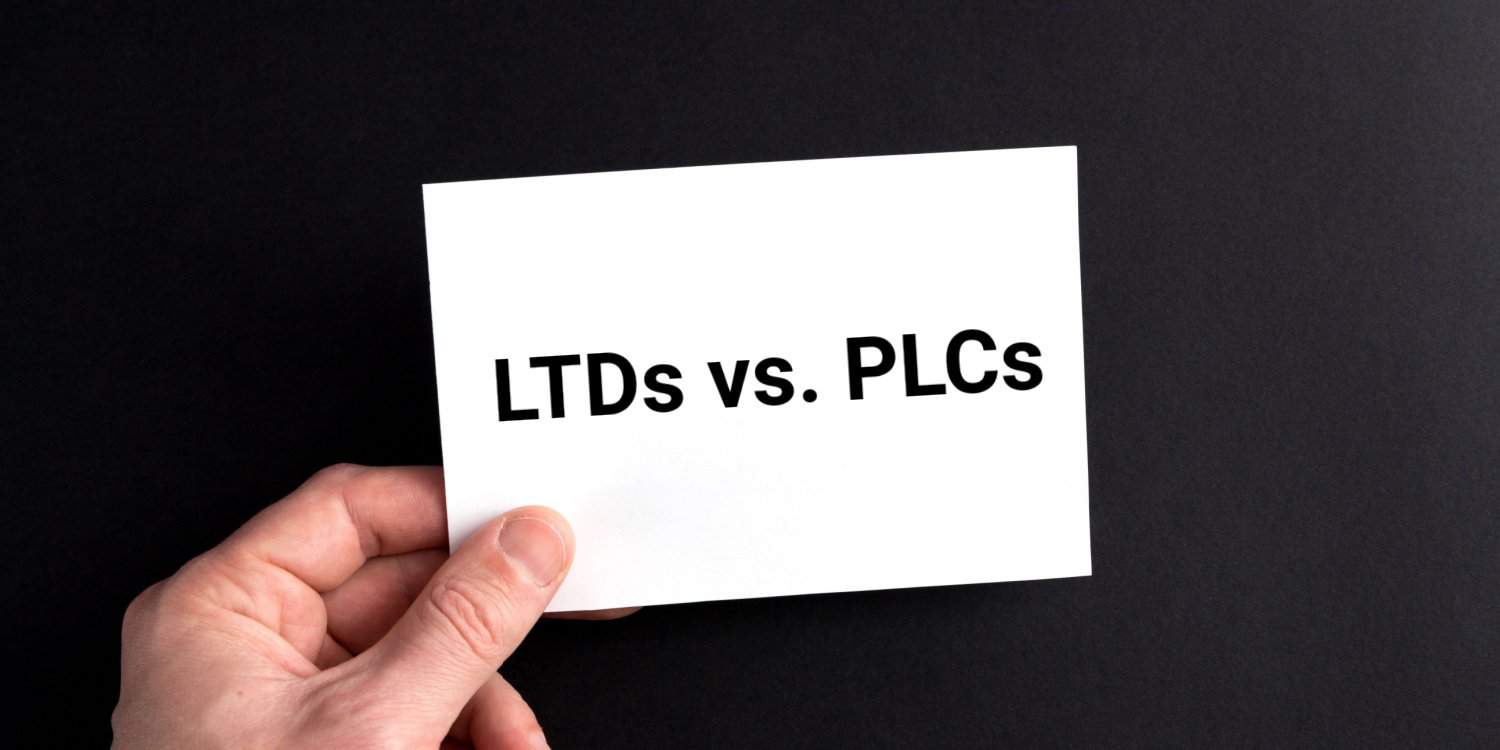Table of Contents
Whilst public limited companies, or PLCs, are not the most popular business structure in the UK – private limited companies make up 95% of companies on the Companies House register – the structure is noteworthy. This is because of its key traits and the perceived calibre of companies that operate through it.
In this article, we place public limited companies alongside private limited companies, and highlight their similarities and differences. Let’s get started.
The main difference between public limited companies and private limited companies
In a PLC, shares can be offered to the public (such as through a stock exchange). In a private limited company (LTD), this isn’t an option. Instead, shares can only be moved privately. This is why we use the terms ‘public’ and ‘private’ when referring to the company types.
Making shares available to the public means raising capital and enabling growth is generally easier for a public limited company when compared to its private counterpart. Plus, thanks to the open nature of stock exchanges, the overall amount of funding that can be obtained will often be larger than what’s available to an LTD through its means of funding.
When discussing the pros and cons of the PLC structure, its strengths are very much concerned with its ability to raise significant capital by being able to offer shares to the public, and the prestige that comes as a result of this. Likewise, the weaknesses associated with the model are linked to the higher standards and extra reporting required to enable being listed.
Other differences between public and private companies
Being able to offer shares to the public is certainly the major difference between the two structures, and typically the reason why someone would choose to register a PLC and not an LTD, but there are other differences. Below we take a look at some of the most important ones:
1. The people within the company
Under the Companies Act 2006, a PLC requires a minimum of two people. That’s two company directors, two shareholders and a fully qualified company secretary. Directors can also be shareholders or secretaries (if they meet the qualification requirements).
Meanwhile, the Companies Act 2006 requires an LTD to have a minimum of one person. In this instance, the individual would be the sole director and shareholder. Secretaries have been an optional appointment in an LTD since 2008.
2. What needs to be reported (and when)
PLCs can’t typically file abbreviated accounts (a “summarised” form of the company’s accounts) and their accounts must always be audited. An LTD, on the other hand, will often be able to file abbreviated accounts, and they will often be exempt from having to have the accounts audited. See here for further guidance on audit exemption.
Additionally, a PLC must deliver its accounts within 6 months of the accounting reference date. LTDs, on the other hand, have a little longer to file, needing to do so only within 9 months from the accounting reference date.
3. Late annual account penalties
Furthermore, if a PLC misses its deadline for filing annual accounts, its late filing fees are significantly more than an LTD would need to pay (fees are doubled for PLCs and LTDs if accounts are delivered late 2 years in a row).
| How late? | Private limited company | Public limited company |
| 1 month or less | £150 | £750 |
| 1 month – 3 months | £375 | £1,500 |
| 3 months – 6 months | £750 | £3,000 |
| 9 months or more | £1,500 | £7,500 |
4. Share buyback out of capital
Although PLCs can generally carry out buybacks of shares (also known as purchase of own shares), they are not permitted to buy back their shares out of capital.
In a share buyback, the company purchases its own shares back from a shareholder, either to be sold on or to be cancelled. They can be funded in several ways, one of which is out of capital.
Funding a buyback out of capital is an option for LTDs, provided that no restrictions are placed in the company’s articles of association.
5. Annual General Meeting (AGM)
PLCs must hold an AGM within 18 months of the company’s incorporation and then, after this, at least once every year.
LTDs have no statutory requirement to hold AGMs, unless the company’s articles of association state otherwise.
6. Immediate cash injection
For a PLC to be able to trade, it must obtain a Trading Certificate from Companies House. This is a separate certificate (not to be confused with the Certificate of Incorporation) that is issued by Companies House.
To be eligible to receive a Trading Certificate, a PLC must have a minimum nominal share capital of £50,000, with at least 25% of this having to be paid up. This means that the company can’t partake in any trading activity until at least £12,500 has been paid into the business.
LTDs do not need a Trading Certificate to start trading and the Companies Act 2006 does not provide a minimum share capital requirement (or requirement for a certain amount of this to be paid up). In effect, they can begin trading as soon as the company is registered, with zero money having been actually received by the company.
Similarities between public and private companies
Naturally, because PLCs and LTDs are types of limited companies, they share several similarities. In this section, we’ll focus on those similarities.
1. Companies House registration
To set up as a PLC or an LTD, registration with Companies House is necessary.
Registration can be completed directly with Companies House or through a company formation agent, such as Rapid Formations.
Once the company has been set up, information about it is published on the Companies House register and is visible to the general public.
2. Company name rules
Given that registration with Companies House is required for both types of companies, it also makes sense that the same rules apply to naming the companies.
PLC and LTD names must be wholly unique, can’t be too similar to other names on the register and can’t be offensive. If a name includes a ‘sensitive word or expression’, approval from a suitable government body must accompany the registration application.
The only difference regarding company names is that PLC names must end with ‘Public Limited Company’ or ‘Plc’ (or the Welsh equivalents) and LTDs must end with ‘Limited’ or ‘Ltd’ or the Welsh equivalents.
3. Limited liability
Shareholders in PLCs and LTDs are both only liable for the amounts that the shares have been issued for (this is often just the nominal value of the shares, which is usually £1.00 per share).
This means that if the company encounters financial difficulties, they will only be liable for the amount they have agreed to pay. The remainder of their personal assets over this amount will be kept safe.
However, because the initial shareholders in a PLC will need to have invested a minimum of £12,500 in the company to facilitate trading, it is important to remember that their liability would generally be higher when compared to shareholders in an LTD.
4. Memorandum and articles of association
Both company types require a set of articles of association to be incorporated. This document is the company’s primary constitutional document, determining how the company is to be governed and run. The content and exact structure of the articles of both company types may differ, however the basic premise remains the same.
What’s more, a memorandum of association is drawn up as part of the registration process. This basic document confirms that the shareholders intend to register a company.
5. People with significant control (PSC) obligations
PLCs and LTDs have a statutory obligation to keep information on their People with Significant Control (PSCs) and report it to Companies House. PSCs are the people who have the ultimate say in how the company operates and who ultimately benefit from it. Whilst it is possible for a company not to have any PSCs (i.e. where no one meets the relevant conditions), in the majority of cases they will, and they will typically also be the shareholders.
That said, PLCs who have shares admitted to certain stock exchanges are exempt from needing to maintain records of their PSCs.
6. Reporting duties
Regardless of whether you are operating as a PLC or LTD, there are several filings that both types of companies need to carry out, namely to Companies House.
For example, you must file an annual confirmation statement, which reports key information about the company. The other annual filing that needs to be submitted to Companies House is the company’s annual accounts, which we discussed earlier. In short, the annual accounts are made up of financial information about the company.
In addition to this, for both company types, Companies House must be informed when certain updates occur. This includes changes to the registered office address and director appointments and resignations.
7. Officers and shareholders
Whilst a PLC needs a secretary and an LTD doesn’t, the other roles and responsibilities within the company are the same. Directors are tasked with the overall day-to-day running of the business and shareholders own the business.
Thanks for reading
So there you have it, the main differences and similarities between public and private limited company structures.
If you’re interested in forming either, we can help.
- To register a public limited company, get in touch with our Company Secretarial Team who will be able to assist you
- To register a private limited company, get started by browsing our company formation packages
If you have any questions, please leave a comment and we’ll get back to you as soon as possible.













